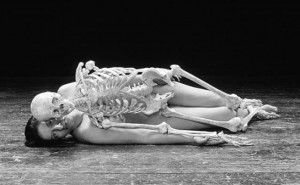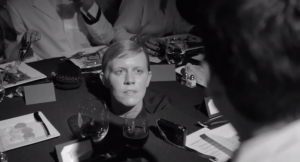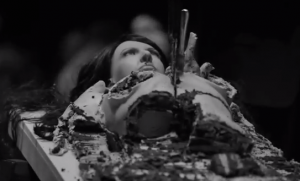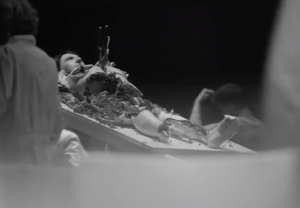Marina Abramović , a famous performance artist who now lives in New York, is a prominent figure in the art community. To understand her work I had to first understand performance art. Basically, it is a form of art that incorporates real personal emotions and interactions usually in the forms of public performances and videos. In one interview, Abramović , who self-identifies as the grandmother of performance art, stated that a performance artist never hesitates to cut or harm his or her own body for the sake of the artistic message because the body is only a canvas. Most of her work consists of very unusual public acts, including nude performances with skeletons and interacting with museum visitors in a previously constructed display, like a large table.

In regards to this class, Abramović’s most relevant art performance was at the MOCA Gala LA in 2011. The event was set up with a large stage in the middle of the room with oval-shaped banquet tables stationed around it, each set with plates and place settings to instruct guests where to sit. Though this set up seems traditional, it was the details of the event that Abramović used to send her artistic message. All servers wore long white coats similar to a doctor’s white coat and each table had a centerpiece either of a skeleton or of a live actor’s head (a hole was cut in the table for the actor to stick his or her head through). For the actors in the tables, I believe they were instructed to act as lifeless as possible. I say this because the footage of the event shows the actors staring at guests with “dead” facial expressions.

After guests were seated, the live performances began. This part of the event included different performances by varying artists, along with Abramović’s reading from a section of her manifesto about the role of the artist in society as an entertainer and a selfless teacher. After this reading, Blondie took the stage and performed her song, “Heart of Glass.” As her performance came to an end, shirtless men brought out two large planks each carrying a large object draped in an opaque shroud. When Blondie finished her song, Abramović came on stage and unveiled the objects. The objects were life-sized naked corpses that each resembled one of the artists on stage. It turns out they were cakes. After handing Blondie a knife, the two artists moved to her own replica cake; Abramović, a brunette, moved to the brunette cake and Blondie moved to the blonde one. Each performer proceeded to stab the woman cake in the heart and hold up handfuls to the audience. It was this action that struck me the most.

Would simply cutting the cake not send a sufficient message? The stabbing act was extremely unsettling for me, and the video of the event made sure to include the reactions of the celebrity guests. The video of the event ends on an image of the devoured woman cake with the serving knife sticking out of its chest; a very unsettling image due to the life-like appearance of the woman cake’s face and the color of the cake.

During this large dinner event, which doubled as a performance art piece, I believe that the corpse cakes were meant to symbolize an artist’s body of work. This is a great example of the symbolism that a corpse can have. Because it is an inanimate object, it innately represents victimization and helplessness. Does this mean that Abramović wished to state that she felt viciously devoured by her audience and fans? But doesn’t she enjoy being an entertainer? Why else would she choose that career? Maybe this was meant to symbolize that she wanted herself to be consumed by her audience, which would mean the corpse cake simply represented herself and her dreams.
Overall, the performance succeeded at evoking profound emotions from the audience, including myself. Abramović’s belief that an artist’s body is a canvas was brought to a new level with the cutting of the cake. I can imagine the discomfort that guests would have felt while eating a cake that was so human-like, which I’m sure Abramović understood. The whole event was raw and unusual, which art should be. Her message was stark and I applaud her methods of pushing the envelope.








